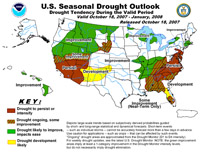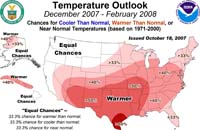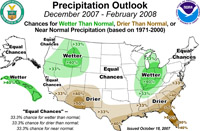NOAA Reports U.S. Winter Forecast Still On Track
Drought Concerns Persist
October 18, 2007

U.S. Seasonal Drought Outlook for October 2007 to January 2008.
+ High Resolution (Credit: NOAA)
In the first scheduled update to the 2007-08 U.S. winter outlook, NOAA seasonal forecasters say the latest data and model runs confirm their earlier prediction for above-average temperatures over most of the country and a continuation of drier-than-average conditions across much of the Southwest and Southeast.
“The prediction for a warmer than normal winter is still on course,” said Michael Halpert, head of forecast operations and acting deputy director of NOAA’s Climate Prediction Center. “Our big concern continues to be the persistence of drought across large parts of the country’s southern tier. Nearly half of the Southeast is in extreme drought and water supplies have reached critical levels in some cities."

Winter temperature outlook for December 2007 through February 2008.
+ High Resolution (Credit: NOAA)
Despite some recent short-term relief over the Southeast and Tennessee Valley, and the potential for additional short-term relief during the next 10 days, NOAA meteorologists predict that the drought will continue through the winter for many areas in the Southeast. Although forecasters cannot rule out much-needed rain in any location in coming months, the latest U.S. drought outlook shows reduced chances for significant relief along the Gulf and Southeast coasts, as the odds for soaking tropical rains diminish as the Atlantic hurricane season winds down.
“Drought is by no means limited to the Southeast, as severe drought expanded northward all the way to Delaware this month. The Washington D.C. area is experiencing one of the most notable dry spells on record, with October 17 the 33rd consecutive day without measurable rain at Reagan National Airport,” said Douglas LeComte, drought specialist at NOAA’s Climate Prediction Center.
Additionally, the onset of La Niña means that drought will likely persist in the Mid Atlantic and the Southwest from Southern California into Arizona. In contrast, the drought forecast shows continued improvement for the Northeast and Great Lakes region, as well as the Northwest and northern Rockies.
“Even though December, January and February are likely to be milder than average for much of the country, people should still expect some typical winter weather this season,” said Halpert.

Winter precipitation outlook for December 2007 through February 2008.
+ High Resolution (Credit: NOAA)
For the country as a whole, NOAA's updated heating degree day forecast for December through February projects a 3.4 percent warmer winter than the 30-year normal, but a 0.7 percent cooler winter than last year.
The 2007-08 U.S. winter outlook will be updated for the final time this season on Nov. 15 at 8:30 a.m. Eastern time.
The U.S. winter outlook is produced by a team of scientists at NOAA’s Climate Prediction Center in association with NOAA-funded partners. Scientists base this forecast on long-term climate trends and a variety of forecast tools from statistical techniques to extremely complex dynamical ocean-atmosphere coupled models and composites.
NOAA is dedicated to enhancing economic security and national safety through the prediction and research of weather and climate-related events and information service delivery for transportation, and by providing environmental stewardship of our nation's coastal and marine resources. Through the emerging Global Earth Observation System of Systems (GEOSS), NOAA is working with its federal partners, more than 70 countries and the European Commission to develop a global monitoring network that is as integrated as the planet it observes, predicts and protects.
